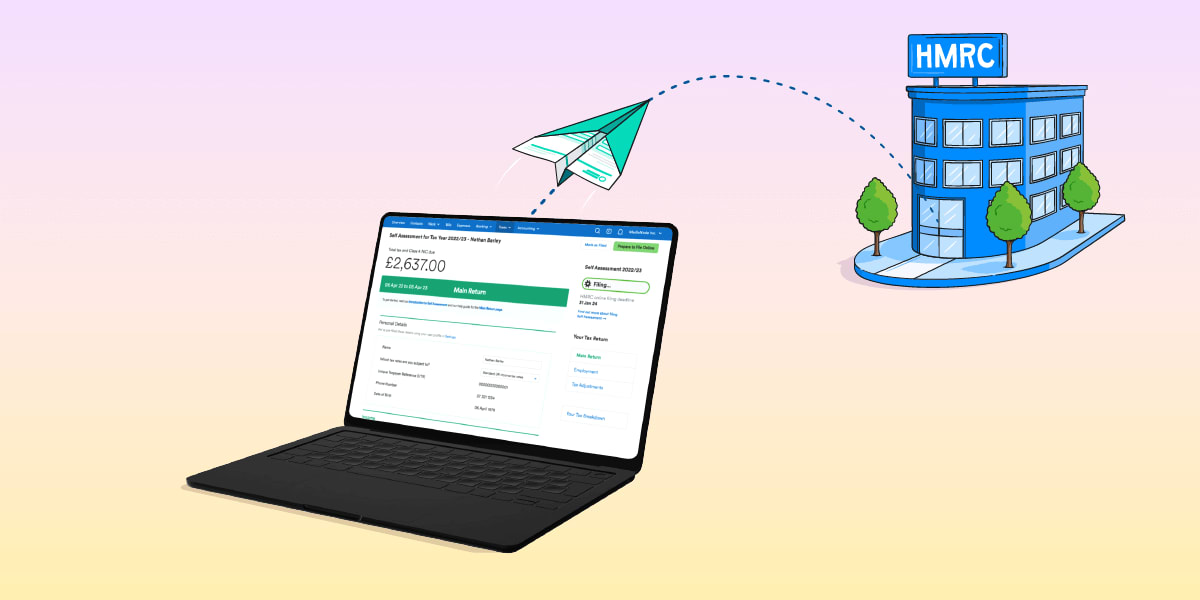Everything you need to know about cashflow
How to create a cashflow forecast

Maintaining a healthy cashflow is essential to ensure small business owners can plan ahead effectively and have money available in case of an emergency.
If you’re a FreeAgent user, our software automatically builds a near-term cashflow forecast for your business, based on the data in your account. However, if you’re interested in creating a longer-term, strategic cashflow forecast for your business, this guide provides a detailed process for you to follow.
What is a cashflow forecast?
A cashflow forecast is a plan that shows how much money you expect your business to receive and pay out over a set period of time. It can help you plan how much you expect to make in sales and spend in costs. It can also help you understand when money will enter and leave your bank account.
In order to build an effective cashflow forecast, we recommend that you also create separate forecasts for your sales and profit and loss.
You’ll use your mini sales forecast to predict your future sales performance. Your mini profit-and-loss forecast is to determine your business’s income less its expenses. You’ll then use your mini cashflow forecast to map out the money coming into, and going out of, your business.
Armed with these component forecasts, you’ll be better placed to make important decisions about your business. Here are some questions that a cashflow forecast can help you answer:
- Can you sell a new product or offer a new service?
- Can you afford to recruit a new member of staff?
- Should you outsource some of your day-to-day tasks?
- Can you afford to rent an office or workshop space if you’re looking to expand?
- Can you sell your product or service in a different country?
- Are you at risk of running low on money?
- Should you borrow some money?
- When can you consider taking more money out of your business?
Before you start
We recommend that you make your forecasts as comprehensive as possible, so remember to include all of your sales, costs and cash transactions. However, your forecast can’t possibly be penny-accurate, so it’s okay to use round numbers.
It’s up to you how far in advance you forecast but bear in mind that the further you try to look ahead, the less likely it is that your cashflow forecast will be realistic. A good rule of thumb is to forecast one year ahead.
We recommend that you update the figures in your forecast if your original plan doesn’t come to pass, for example if a new product sells better than you expected.
Step 1: create a mini sales forecast
We recommend that you create your mini sales forecast first so you can plan how much you expect to sell in the future.
Take a look at Sheet D in our handy cashflow forecast template. You’ll see that we’ve set up the template with a column for each month and a row for each product or service that you sell. We’ve also included a total column and total row. The total row is particularly important because it’ll feed across to your mini profit-and-loss forecast.
If you’re not sure where to start when predicting your future sales figures, here are a few pointers:
- Think about what your objectives are, such as launching a new product or expanding into a new market. If you’re aiming to make more sales in a particular area, then consider building this into your mini sales forecast.
- Can you see any trends in your previous year’s sales figures, such as seasonal variations?
- Are you hoping to win any new contracts and how likely is it that you’ll be awarded those contracts? Will working on new contracts take time away from other work?
- If your business is registered for VAT, remember to record your sales exclusive of this tax.
- What is your sales mix? In other words, how much of each of your different goods and services do you usually sell? How much money do they bring in?
Example of a mini sales forecast
Let’s look at an example. You can follow along in Sheet A of the cashflow template.
Your mini sales forecast: Inkredulous
Imagine you’re an illustrator who’s looking to create a cashflow forecast for your business, which is called Inkredulous. You’re looking at your expected sales for the year ahead.
For this example, you might expect your sales to come from three different sources:
- You provide illustrations for an author, Rob, who plans to write a new book early next year.
- You expect to win a contract to draw an online comic strip series.
- You also carry out ad-hoc work illustrating greetings cards and would like to expand this side of your business.
You plan your sales for next year. You enter your three sales channels: Rob’s new book, the comic strip and the greetings cards, on different rows of the spreadsheet.
You record when you expect to do the work, not when you expect to be paid for the work. This is important because you will need to draw up a mini profit-and-loss forecast on the basis of when you earn money and when you incur your costs.
You record your sales in round numbers, because this is a forecast rather than an exact prediction.
Next, you add your sales revenue to the spreadsheet. This is how much you expect to earn from sales. You can calculate this by taking the number of units of product (e.g. the number of illustrations) you expect to sell and then multiplying this figure by the expected price for each unit.
Alternatively, you can think in terms of revenue only (e.g. a total fee for Rob’s book rather than a fee per illustration).
Step 2: create a mini profit-and-loss forecast
Now that you’ve predicted your sales, it’s time to create your mini profit-and-loss forecast. This mini forecast combines your business’s income and its day-to-day running costs, giving you a view of your projected profit in the future.
Here are some pointers for creating your mini profit-and-loss forecast:
- While you’ll prepare your mini cashflow forecast on the basis of payment dates, it’s better to prepare your mini profit-and-loss forecast on the basis of when you expect to incur costs.
- If you sell goods then you’re likely to have costs of sales (e.g. for raw materials). You can adjust your figures to allow for stock you held at the start and end of each month and then add a row for gross profit.
- Remember to include any day-to-day running costs other than cost of sales; these costs are also known as overheads. You can then work out your business’s net profit.
- Keep in mind that you should only include your business’s day-to-day running costs in your mini profit-and-loss forecast. You shouldn’t include one-off costs to buy new equipment, such as buying a new computer.
- Don’t forget to include costs for stationery and consumables, such as packaging, printed letterheads, business cards, sticky notes, computer cables and batteries. If you’re not sure how much these items will cost, you can take a look at past receipts.
- Include any monthly or annual subscription costs, such as software packages and web hosting, as well as any fees for accountants, solicitors or freelance contractors.
- Don’t forget to include any costs for landlines, mobile phones or any call answering services you may use.
- If you’re an employer, you can add your employees’ wages to the ‘staff salaries’ row. Don’t forget to add in any taxes that you pay in addition to employees’ wages, such as employer’s National Insurance contributions.
- If you’re registered for VAT, then include your costs exclusive of this, unless you’re using a scheme through which you report your costs inclusive of VAT, such as the VAT Flat Rate Scheme.
- Don’t forget to include any non-cash costs, such as depreciation of your assets, miles travelled in your own car and business use of your home.
Example of a mini profit-and-loss forecast
Let’s look at the example we’ve created in Sheet B of the cashflow template:
Your mini profit-and-loss forecast: Inkredulous
Sales
Take a look at Sheet E of the cashflow template. You’ll see that this is already set up with a column for each month. You can use the first row of this to record your total sales, which should be pulled automatically from your mini sales forecast in Sheet D.
Costs of sales
As an illustrator, your costs of sales might be your pens, sketch pads and drawing paper. The more illustrations you produce, the more of these items you’ll need.
Overheads
You send your illustrations to Rob electronically, so you won’t have costs of physical delivery for that project. You expect to use the same delivery method for the new comic strip contract.
However, you will need to post your greetings cards, so you’ll need to include the costs of packaging and delivery for them. These costs will depend on how many cards you sell, so you can refer back to your mini sales forecast to work this out.
You also use your website to display some of your work and attract new customers. You include the cost of hosting the website each month in your mini profit-and-loss forecast.
You add up the costs of your subscriptions for online accounting software, project management software and to-do lists and include these costs in your mini profit-and-loss forecast.
Your accountant invoices you in March each year, so you include this as a cost based on the accountant’s invoice date.
You also include the costs of your landline, mobile phone and broadband internet in the ‘telephone and internet’ area of your mini profit-and-loss forecast.
You enter an allowance for office consumables, such as batteries for your mouse and bulbs for your desk lamp.
You include the depreciation of your business’s assets, such as office furniture and computer equipment.
Your accountant advises you on how much to include as allowances for business use of your home and mileage travelled in your own car.
Once you’ve mapped all your costs, you add them up and then subtract your costs from your sales in order to work out your business’s net profit.
You can clearly see your business’s seasonal peaks and troughs. You make a lower profit in the early part of the year and a higher profit in the later part of the year when your sales are greater.
You are not happy with the amount of sales revenue, especially when you consider that you have to pay tax on your profit. You consider whether you should put your prices up.
Step 3: create your mini cashflow forecast
Now you’ve created your mini sales and profit-and-loss forecasts, you can use them to map your mini cashflow forecast.
In Sheet F of the cashflow template we’ve created:
- a column for each month
- a row for each type of money coming in or going out
Use your mini sales forecast to bring across your sales income and then bring across the appropriate costs from your mini profit-and-loss forecast.
Here are some more pointers for creating your mini cashflow forecast.
Money coming in
While you report income when it’s invoiced on your mini sales forecast, you need to list income when you expect it to be paid on your mini cashflow forecast. The income might be received after the invoice date or, if you take deposits, before it.
If your business is registered for VAT then you should include your sales income inclusive of this tax. Be aware that this means that your sales income on your mini cashflow forecast will be different from your sales income on your mini sales forecast, which includes income exclusive of VAT.
Think about any income other than sales (e.g. a loan) that you can expect. You can add this income to your mini cashflow forecast, using a separate row for each type of income.
You can use the ‘total money in’ row of the template to total up all the money that you’re expecting to come in.
Money out
You should list your costs when you expect to pay for them, rather than when you expect to incur them.
If any costs include VAT and you’re registered for this tax, remember to record these costs inclusive of VAT. This is different to the mini profit-and-loss forecast, where you included costs exclusive of VAT.
Remember to leave out non-cash costs like mileage and depreciation. Don’t forget to include any money you withdraw from the business for your own personal use.
Add up all the money you expect to spend each month and subtract that figure from the money you predict will come in each month. You can then see your net cash inflow (how much more you’ve brought in than spent each month) or your net cash outflow (how much more you’ve spent than brought in each month). We’ve done this automatically for you in the ‘net cash inflow/outflow’ row of the cashflow template.
Add your net cash inflow or outflow to your bank balance as at the end of the previous month to see how much you expect to have in the bank at the end of the current month. This can help you make decisions for your business, such as whether you want to raise your prices or recruit a new team member.
Example of a mini cashflow forecast
Let’s jump back into our example. You can follow along in Sheet C of the cashflow template.
Your mini cashflow forecast: Inkredulous
You use your mini sales forecast to complete the ‘money in’ section of your mini cashflow forecast:
- You are registered for VAT, and pay the standard rate of 20%, so you include the VAT that your customers will pay you.
- Rob pays you straight away, so you include these sales in your mini cashflow forecast in the same months that they appear in your mini sales forecast.
- The payment terms for your potential comic strip illustration contract are one month in arrears (when a payment is made after the product or service has been provided). You’ll include those sales in your mini cashflow forecast a month later than you put them into your mini sales forecast.
- The greetings card company also pays you one month in arrears, so you’ll include those sales in your mini cashflow forecast a month after they appear in your mini sales forecast.
- In case you need to borrow money from the bank, you include a row for money coming in from a business loan.
- With all of the money added, you also add a row to total all of these amounts.
You look at your mini profit-and-loss forecast to plan when you expect money to leave your bank account - the ‘money out’ section of your forecast:
- You pay most of your costs in the same month as you incur them, so you include them in your mini cashflow forecast in the same month as they appear in your mini profit-and-loss forecast. You enter your costs inclusive of VAT at the appropriate rate.
- You pay your accountant one month in arrears. You put that cost into your mini cashflow forecast a month after it appears in your mini profit-and-loss forecast, inclusive of VAT because your accountant charges him VAT.
- Depreciation, business use of your home and mileage in your own car are all non-cash costs, so you leave these out of your mini cashflow forecast.
Once you’ve brought in all the appropriate day-to-day running costs, you think about other cash payments your business might make, which will also need to be added to ‘money out’:
- You want to buy a new computer at the end of the year, so you include that.
- You’ll pay VAT every quarter based on the amount that you’ve invoiced your customers, minus the amount that you’ve incurred on costs. You need to include this amount in each month that you expect to pay your quarterly VAT bill.
- Don’t forget money you personally take out of the business. As you’re a sole trader, this would be drawings. For partners in a partnership, this would also be drawings. If you’re operating your business as a limited company, remember your salary, any dividends and any loan repayments the business is making to you.
- You include a row for any repayments you’re making towards business loans.
- You add up your outgoings and then subtract these from your monthly income to calculate your net cash inflow or outflow.
Your cashflow and cash position
Having completed all of the above, you can see that your business has a net cash outflow in several months’ time. This means that you’ll be spending more than you’re bringing in.
You enter your business bank account balance as it stood at the start of January and look to see how much you expect to have in the bank at the end of each month.
Based on what you’ve entered, you’re expecting to be overdrawn. This means you might need to consider putting an overdraft facility in place and perhaps arranging for a formal loan with the bank. You consider whether you should raise your prices or find additional ways to make more sales, perhaps through an e-commerce site of your own.
If you hadn’t created your cashflow forecast, you wouldn’t have known that you’re at risk of running out of cash and becoming overdrawn.
By taking the time to create your cashflow forecast now and adapting it as the months unfold, you’re giving your business the best possible chance of success in the year ahead.


